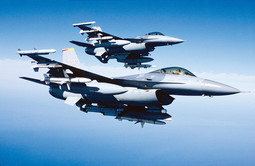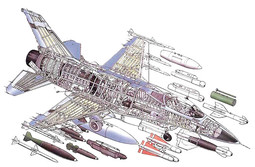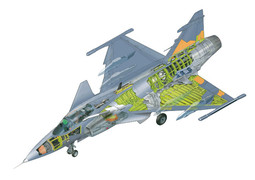Published in Nacional number 601, 2007-05-22
NEW FIGHTERS ON PLESO AIRPORT BY 2011
F-16 vs. Gripen - Croatian Air Force To Spend 800 Million $ For New Wings
THE NEW CROATIAN GOVERNMENT faces the costliest-yet project of equipping the Croatian Armed Forces: the purchase of 12 modern fighter-bombers needed for NATO
 F-16Immediately following the parliamentary elections in November and the forming of a new Croatian Government, the future defence minister will at the start of their mandate face what will be so far the most complex and most expensive project in equipping the Croatian Armed Forces, three times more expensive than the procurement of armoured battle vehicles. In question is the purchase of 12 multi-purpose fighter planes for the needs of the Croatian Air Force, worth some 800 million US dollars.
F-16Immediately following the parliamentary elections in November and the forming of a new Croatian Government, the future defence minister will at the start of their mandate face what will be so far the most complex and most expensive project in equipping the Croatian Armed Forces, three times more expensive than the procurement of armoured battle vehicles. In question is the purchase of 12 multi-purpose fighter planes for the needs of the Croatian Air Force, worth some 800 million US dollars.
The procurement of the multi-purpose aircraft has to start next year by the latest, and the decision on which aircraft Croatian pilots will be flying to control Croatian airspace will be adopted by the end of 2009, as the current MiG-21s are slated for withdrawal by 2010. The introduction of new aircraft in the battle squadron of the 91st Air Force base at Zagreb's Pleso Airport should start in 2011. In the race for the equipping of the Croatian squadron of fighter aircraft, according to the available information, are single-engine supersonic aircraft – the Swedish multi-purpose JAS-39 Gripen, and the American F-16 Block 52, as the latest F-16 Block 60 has shown itself to be overly expensive (85 million dollars). France's Dassault Mirrage 2000 is on its way out and is to be replaced in a few years by the Rafale, as soon as it reaches full operational capability, so that the French aircraft was never seriously considered as a Croatian option. The cited Gripen and F-16 Block 52 aircraft have for some time now been mentioned as the only competitors, for which there are several reasons.
Croatia needs a supersonic multi-purpose aircraft capable of interception in our airspace in as short a period as possible, it has to be of modern construction, relatively small in size with electronic systems and weaponry compatible to NATO systems and it has to be easy to maintain. The aircraft must be easy to operate with the option of a quick transformation from hunter-interceptor to hunter-bomber. Croatia is not a wealthy country, it does not have a large airspace, there are no real military threats on the long term, and it has not and will not declare its military aircraft ready for possible deployment to NATO combat missions. It therefore does not require twin-engine aircraft with a range of over 4,000 km, capable of carrying somewhat more weaponry than single-engine aircraft. Besides that, when it enters NATO, Croatia's defence strategy, because of the policy of the international community towards South Eastern Europe, will have neither the need nor the possibility of flexing its air power and military might in the region, as it will become a part of a collective security system.
 F-16All of this means that the Eurofighter Typhoon, and the American F-15 were rejected straight off, which also goes for the Russian Suhoj-35 and MiG-29 aircraft, whose operational expenses are triple that of the western aircraft. Croatian does not need twin-engine aircraft not only because of its small territory and its defence strategy, but also because they are simply too expensive. The price of that kind of fully equipped aircraft in a package including pilot training, technical staff and reserve engine reaches from 110 to 120 million dollars. The procurement of a multi-purpose airplane is a major challenge for the Croatian Air Force and its technical services, because after decades of maintaining and operating now completely obsolete Russian technology, Croatian air personnel will have to learn a completely new technology and logistics system.
F-16All of this means that the Eurofighter Typhoon, and the American F-15 were rejected straight off, which also goes for the Russian Suhoj-35 and MiG-29 aircraft, whose operational expenses are triple that of the western aircraft. Croatian does not need twin-engine aircraft not only because of its small territory and its defence strategy, but also because they are simply too expensive. The price of that kind of fully equipped aircraft in a package including pilot training, technical staff and reserve engine reaches from 110 to 120 million dollars. The procurement of a multi-purpose airplane is a major challenge for the Croatian Air Force and its technical services, because after decades of maintaining and operating now completely obsolete Russian technology, Croatian air personnel will have to learn a completely new technology and logistics system.Up to now the publicly oft-cited price of a new aircraft of the Gripen or F-16 type was from 35 to 45 million euros a piece, which is incorrect, that is to say correct only if a country wished to purchase a "naked" airplane lacking its sophisticated equipment and pilot training program. In expert aircraft circles this is known as the fly away price. But with a complete package of pilot training on a simulator and in the air, with the training of technical staff, spare parts and land equipment, then the price for a Gripen is around the 68 million dollars paid for them by the Czech Republic and some 10% more for the F-16, around the 74 million dollars paid by Poland. This simplified comparison is not, however, key in making a decision, even though a 6 million dollar difference for the American aircraft is certainly important when it comes to not-so-wealthy Croatia, because in the end it means giving 72 million dollars more or less for a total of 12 aircraft. It is however much more important to regard the procurement cost through the aspect of their service life, which ranges from 25 to 30 years.
In consideration then are concrete and available data on the price of flying per hour. According to the available official data, the cost of an hour of airtime on a Swedish Gripen is 2,500 dollars, while an airborne hour on the F-16 Block 52 comes to 3,700 dollars. If we take into consideration that Croatian plots might spend 50 hours in the air a year, still well below the NATO standard (150 airborne hours), the cost of flying one Croatian pilot in a Gripen would come to 125 thousand dollars a year, and 185 thousand for the F-16. Annual costs and the difference in operational costs increase if we calculate the annual airborne time of all Croatian pilots of some 600 hours.
 GripenIn that case the total price of using the Gripen comes to 1.5 million US dollars a year, while the estimated price for an F-16 is 2.2 million dollars a year. For a 25-year service life one would have to earmark 37.5 million US dollars for the Gripen and 55 million dollars for the F-16. It should be noted that minimal airtime has been used in this calculation, as the costs would triple based on the NATO-standard flight regime of 150 hours. The difference in annual operational costs between the two aircraft arise from the fact that the Gripen consumes less fuel, is easier to repair, needs a smaller maintenance staff of 60 people a year, unlike the F-16 which requires the attention of 230 people, that number relevant for a 150 hour annual airborne time. The Gripen also needs less ground maintenance equipment and a longer period between breakdowns. What can be considered an advantage for the F-16 is a greater mission range, as the Gripen has a maximum range of 3000 km, and the F-16 of 3900 km.
GripenIn that case the total price of using the Gripen comes to 1.5 million US dollars a year, while the estimated price for an F-16 is 2.2 million dollars a year. For a 25-year service life one would have to earmark 37.5 million US dollars for the Gripen and 55 million dollars for the F-16. It should be noted that minimal airtime has been used in this calculation, as the costs would triple based on the NATO-standard flight regime of 150 hours. The difference in annual operational costs between the two aircraft arise from the fact that the Gripen consumes less fuel, is easier to repair, needs a smaller maintenance staff of 60 people a year, unlike the F-16 which requires the attention of 230 people, that number relevant for a 150 hour annual airborne time. The Gripen also needs less ground maintenance equipment and a longer period between breakdowns. What can be considered an advantage for the F-16 is a greater mission range, as the Gripen has a maximum range of 3000 km, and the F-16 of 3900 km.Some are inclined to claim that used F-16s should be purchased for the coming 5-10 years for financial reasons. "There has been no discussion of Croatia having already decided to replace its fleet of MiGs by 2010 with used American F-16s, and even less so that an arrangement for 12 used aircraft would cost about 100 million dollars, as has been speculated upon in the public. At a price of 10 million US dollars we can get, roughly put, the hull of a used airplane with wings and a 15 year-old cabin. If this kind of arrangement were to actually take place, Croatia would have to pay at least 230 million dollars for 12 aircraft, including pilot and mechanic training, ground infrastructure, spare parts, to say nothing of rocket systems and bombs, so that the price could climb to 400 million. Besides all that, an hour of flying time in a used aircraft of this kind costs 5,360 dollars, and that is the official data of the US National Guard, which means that the costs of an airborne hour are double that of an hour's flight in a new airplane", Nacional was told by a high ranking source at the Croatian Air Force.
 GripenAccording to the claims of sources close to the Croatian Air Force command the price of a used aircraft depends on the condition it is in and how many hours of flight it has seen, while the production date is less important as aircraft can be older but conserved and with less airborne hours. The condition of the construction is not the only thing taken into consideration, as there is also the engine to take into consideration, and the condition of the engine chassis, i.e. the entire propulsion system is a topic to itself. The durability of an aircraft is an individual notion: individual aircraft can be a limited resource on account of, for example, their wings or landing gear because of landings in varied conditions. It is very important to know what country used them previously, on what airfields, in what kind of combat activity and so forth. When speaking of the F-16 there should be no doubt that most of them were involved in combat operations around the world from the early 1990s on: from Iraq to Bosnia & Herzegovina, Kosovo and Serbia. Some media have entirely unfoundedly already said that Croatian has opted for used F-16 aircraft, having quite erroneously interpreted the Armed Forces Long Term Development Plan that states Croatian Air Force investments up to 2015 will come to about 3.4 billion kunas, and concluded from this that that was an amount insufficient for the purchase of new Gripens, which would cost in the neighbourhood of 4.6 billion kunas or 800 million dollars.
GripenAccording to the claims of sources close to the Croatian Air Force command the price of a used aircraft depends on the condition it is in and how many hours of flight it has seen, while the production date is less important as aircraft can be older but conserved and with less airborne hours. The condition of the construction is not the only thing taken into consideration, as there is also the engine to take into consideration, and the condition of the engine chassis, i.e. the entire propulsion system is a topic to itself. The durability of an aircraft is an individual notion: individual aircraft can be a limited resource on account of, for example, their wings or landing gear because of landings in varied conditions. It is very important to know what country used them previously, on what airfields, in what kind of combat activity and so forth. When speaking of the F-16 there should be no doubt that most of them were involved in combat operations around the world from the early 1990s on: from Iraq to Bosnia & Herzegovina, Kosovo and Serbia. Some media have entirely unfoundedly already said that Croatian has opted for used F-16 aircraft, having quite erroneously interpreted the Armed Forces Long Term Development Plan that states Croatian Air Force investments up to 2015 will come to about 3.4 billion kunas, and concluded from this that that was an amount insufficient for the purchase of new Gripens, which would cost in the neighbourhood of 4.6 billion kunas or 800 million dollars.They did not, however, take into consideration that the closing of a deal on the purchase of a multi-purpose aircraft is expected for 2010 and that payments would be made in ten annual instalments up to 2020. That makes the sum of 3.4 billion kunas quite sufficient for the payment of five annual instalments for the new aircraft, not to mention the possibilities of a grace period, already announced. Besides, no one can say anything yet with certainty, as the decision on the entire matter will be made by a new Croatian Government following the parliamentary elections in November.
The Gripen faces the future, the F-16 is testedThe F-16 can carry a complement of somewhat more weaponry than the Gripen, and has been in production for a longer period, with a total of 4,200 units already manufactured, while Gripen has so far manufactured 200 aircraft. Besides that the F-16 has shown itself to be a very good aircraft in US Army combat operations around the world over the past 15 years. Unlike the F-16 however, the Swedish Gripen requires a shorter takeoff and landing strip, 500 metres for take off and 400 for a full stop after touchdown without use of its additional braking parachute. Funds for new technologies research and development on the F-16 have been for the large part shifted by US military strategists to the F-35 aircraft, and there is growing speculation that the production of F-16s will be terminated within a decade. The Gripen is a new aircraft facing the possibility of additional development and modification.
Latest news
-
28.10.2010. / 14:15
'A profitable INA is in everyone's interest'
-
28.10.2010. / 09:38
Sanader’s eight fear SDP — Won’t bring down Government
-
21.10.2010. / 15:02
Interior Ministry turned a blind eye on Pukanic assassination
-
20.10.2010. / 09:34
Barisic could bankrupt HDZ



